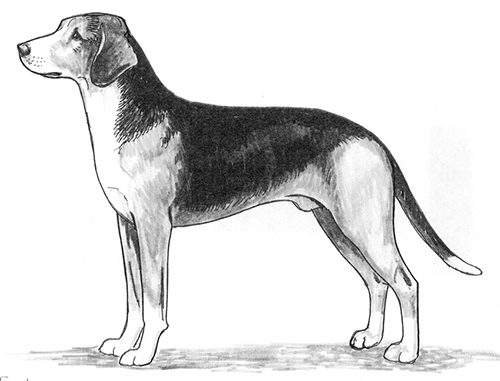Serbian Tricolor Hound
Scenthound Group
The goals and purposes of this breed standard include: to furnish guidelines for breeders who wish to maintain the quality of their breed and to improve it; to advance this breed to a state of similarity throughout the world; and to act as a guide for judges.
Breeders and judges have the responsibility to avoid any conditions or exaggerations that are detrimental to the health, welfare, essence and soundness of this breed, and must take the responsibility to see that these are not perpetuated.
Any departure from the following should be considered a fault, and the seriousness with which the fault should be regarded should be in exact proportion to its degree and its effect upon the health and welfare of the dog and on the dog’s ability to perform its traditional work.
History
The Serbian Tricolor Hound has the same origins as the other Balkan scenthounds. It was originally considered a variety of the Serbian Hound, but was given its own breed status in 1946, though except for color the standards are nearly identical.
The Serbian Tricolor Hound was recognized by the United Kennel Club in 2006.
General Appearance
Medium sized, short coated hound, with a robust constitution.
Characteristics
Lively, kind and dependable, with great tenacity.
Head
The head is long and narrow, with divergent planes.
SKULL
The skull is slightly rounded and has a pronounced frontal furrow. It is longer than it is wide. The stop is almost imperceptible.
MUZZLE
The muzzle is just slightly shorter than the skull. It tapers in width progressively from the eyes to the nose. The nasal bridge is straight. The cheeks are flat. The upper lip overhangs the lower lip. The edges of the lips should be black.
TEETH
The Serbian Tricolor Hound has a complete set of evenly spaced, white teeth meeting in a scissors or level bite.
Disqualifications: Undershot. Overshot. Missing teeth other than the PM 1’s.
NOSE
The black nose is well developed.
EYES
The medium size, oval shaped eyes are set slightly obliquely. The eyes and the eyerims are as dark as possible.
Disqualification: Blue eyes.
EARS
High set, thin and pendulous, the ears are rounded at the tips.
Neck
Approximately the same length as the head, strong and well arched.
Forequarters
The shoulder blades and upper arms are long and form an angle of approximately 90 degrees.
FORELEGS
The elbows are close to the body. The legs are strong, with flat bone. The distance from the elbow to the ground is one half the height at the withers. The pasterns are slightly sloping.
Body
The body is slightly longer than tall. The chest is deep and wide. The withers are slightly pronounced, and the back is long, strong and straight. The loin is muscular, and the croup is slightly sloping, broad and muscular. There is a slight tuck-up.
Hindquarters
The hindquarters are strong, with flat musculature.
HIND LEGS
The upper and lower thighs are approximately the same length. The stifle angulation is 120 degrees. The hock is low and powerful, with angulation of 140 degrees. The rear pasterns are strong and nearly vertical.
Feet
The cat feet have solid, tight toes.
Tail
The tail set follows the natural line of the croup. It is strong at the base and tapers to the tip, which reaches to the hock. The tail is carried in a slight curve below the line of the back. It is covered with abundant hair.
Coat
Short, thick, abundant and shiny, the coat may be slightly longer on the back of the thighs and the underside of the tail. There is a good undercoat.
Color
Base coat of red, with a black mantle or saddle. There is a white blaze on the head, and a complete or partial white collar on the neck. There may be white on the chest that reaches to the belly and the insides of the legs. The tip of the tail may be white. The white markings may not make up more than one-third of the body color.
Disqualification: Red or black ticking in the white markings. White that covers more than one third of the body. The presence of a fourth color.
Height
Height for males is 18 to 22 inches. For females, it is 17 to 21 inches.
Gait
Free and energetic at the trot.
Eliminating Faults
(An Eliminating Fault is a Fault serious enough that it eliminates the dog from obtaining any awards in a conformation event.)
Over or under the prescribed height.
Disqualifications
(A dog with a Disqualification must not be considered for placement in a conformation event, and must be reported to UKC.)
Unilateral or bilateral cryptorchid.
Viciousness or extreme shyness.
Albinism.
Undershot.
Overshot.
Missing teeth other than the PM 1’s.
Blue eyes.
Red or black ticking in the white markings.
White that covers more than one third of the body.
The presence of a fourth color.

Looking for a Dog?
Find a dog that will fit your family.
Note: The breeders on this list are not endorsed by UKC.
Revised July 1, 2009
©Copyright 2006, United Kennel Club
